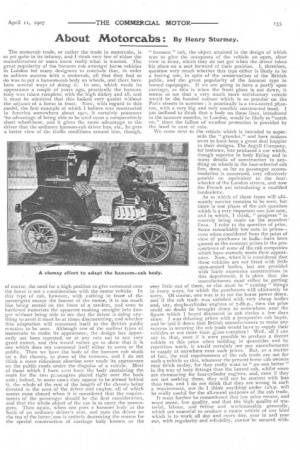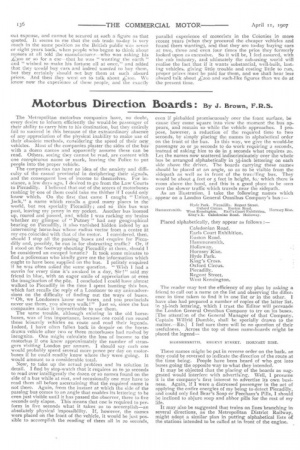About Niotorca.bs : By Henry Sturrney.
Page 3

Page 4

If you've noticed an error in this article please click here to report it so we can fix it.
The motorcab trade, or rather the trade in motorcabs, is as yet quite in its infancy, and I think very few of either the manufacturers or users know really what is wanted. The great popularity of the hansom cab amongst horse vehicles in London led many designers to conclude that, in order to achieve success with a motorcab, all that they had to do was to put a hansom-cab body on wheels, and there have been several ways of doing it. In one, which made its appearance a couple of years ago, practically the hansom body was taken complete, with the high dickey and all, and it must be admitted that this looked very quaint without the adjunct of a horse in front. Now, with regard to this model, the first example of which I believe was constructed in America somewhere about toot, it certainly possesses he advantage of being able to be used upon a comparatively short wheel-base, and it gives the same advantage to the driver that the ordinary hansom-cab driver has, viz., he gets a better view of the traffic conditions around him, though, of course, the need for a high position to give corn mand over the horse is not a consideration with the motor vehicle. In this type of cab, however, with nothing in front of the passengers except the bonnet of the motor, it is too much like being seated on the front of a tandem, and even to hardened motorists the apparent rushing straight into danger without being able to see that the driver is doing anything to avert it must be at times disconcerting, and whether this adaptation will commend itself to the British public remains to be seen. Although one of the earliest types of motorcabs to make its appearance, the design has apparently not been repeated, or at any rate not to any very great extent, and this would rather go to show that it is one which does not commend itself either to users or the public. Then we have the body of the hansom cab stuck on a fiat chassis, in place of the tonneau, and I do not think a more ridiculous abortion ever made its appearance on the public roads under the disguise of a vehicle. Most of those which I have seen have the body containing the seats for the two pa3sengers placed right over the back axle ; indeed, in some cases they appear to be almost behind it, the whole of the rest of the length of the chassis being devoted to the uses of the driver and engine, all of which seems most absurd when it is considered that the requirements of the passenger should be the first consideration, and that the whole object of the car is to carry the passengers. Then again, when one puts a hansom body at the back of an ordinary driver's seat, and puts the driver on the top of the latter, one is entirely destroying the reason for the special construction of carriage body known as the " hansom " cab, the object attained in the design of which was to give the occupants of the vehicle an open, clear view in front, which they do not get when the driver takes his place on a seat forward of their position. I, therefore, question very much whether this type either is likely to be a lasting one, in spite of the conservatism of the British public, and the great popularity of the hansom type in horsed equipages. If we are going to have a partly open carriage, as this is when the front glass is not down, it seems to me that a very much more satisfactory vehicle would be the hooded voiture which is so popular on the Paris streets in summer : it practically is a two-seated phaeton, with a very big and very sensibly constructed hood. I am inclined to think that a body on these lines, introduced in the summer months, in London, would be likely to ',catch on," since the fullest of weather protection is provided by the hood in case of rain.
We conic next to the vehicle which is intended to supersede the " growler," and here makers seem to have been a great deal happier in their designs. The Argyll Company, for instance, has produced a car which, though superior in body fitting and in many details of construction to anything on wheels in the four-wheeled cab line, does, so far as passenger accommodation is concerned, very effectively provide an equivalent to the fourwheeler of the London streets, and now the French are introducing a modified landaulette.
As to which of these types will ultimately survive remains to be seen, but there is one phase of the cab question which is a very important one just now, and in which, I think, " progress " is scarcely being made on the soundest' lines. I refer to the question of price. Some remarkably low cuts in prices— even when considered from the point of view of purchases in bulk—have been quoted as the contract prices in the prospectuses of some of the cab companies which have recently made their appearance. Now, when it is considered that these vehicles are not fitted with little open-seated bodies, but are provided with fairly expensive constructions in this department, it is plain that the manufacturers must either be getting. very little out of them, or else must be " cutting " things in many ways, for which the purchasers will ultimately be sorry. Of course, one way is to cut the horse power down, and if the cab trade was satisfied with very cheap bodies and, say, single-cylinder engines of 7-8h.p., then the price could no doubt be brought down to somewhere near the figure which I heard discussed in cab circles a few days since. I was debating prices with a prospective cab buyer, and he laid it down that British manufacturers to make any success in securing the cab trade would have to supply their vehicles at not more than ;6200 complete l Well, all I can say is, that, even if it were possible to produce a decent vehicle at this price when building in quantities and by repetition work, it would certainly not pay manufacturers to supply at anywhere near such prices. But, as a matter of fact, the real requirements of the cab trade are not for such a vehicle as this, whatever the present horse cab owners may think to-day, for they really want to " go one better" in the way of body fittings than the horsed cab, whilst some are clamouring for four-cylinder engines, and, even if they are not seeking these, they will not be content with less than two, and I do not think that they are wrong in such a requirement, nor do I think anything under x2h.p. will be really useful for the all-round purposes of the cab trade. It must further be remembered that low price means, and must mean, low quality, and that the high quality of material, labour, and fitting and workmanship generally, which are essential to produce a motor vehicle of any kind which is to work all day and every day, year in and year Out, with regularity and reliability, cannot be secured with, out expense, and cannot be secured at such a figure as that quoted. It seems to me that the cab trade to-day is very much in the same position as the British public was seven or eight years back, when people who began to think about motors at all told the manufacturer—who was asking his £300 or so for a car—that he was " wanting the earth " and " wished to make his fortune all at once," and added that they would buy cars and indeed wanted to buy them, but they certainly should not buy them at such absurd prices. And then they went on to talk about -L.100. Wu know now the experience of these people, and the exactly
parallel experience of motorists in the Colonies in more recent years (when they procured the cheaper vehicles and found them wanting), and that they are to-day buying cars at two, three and even four times the price they formerly looked upon as excessive. So it will be, I feel assured, with the cab industry, and ultimately the cab-using world will realise the fact that if it wants substantial, well-built, lasting vehicles, giving little trouble and costing little to run, proper prices must be paid for them, and we shall hear less absurd talk about -4,...;200 and such-like figures than we do at the present time.






























































